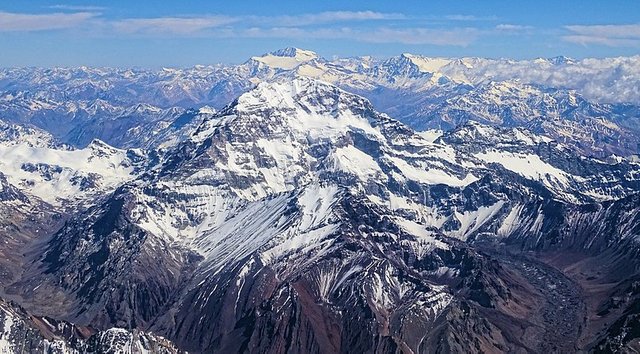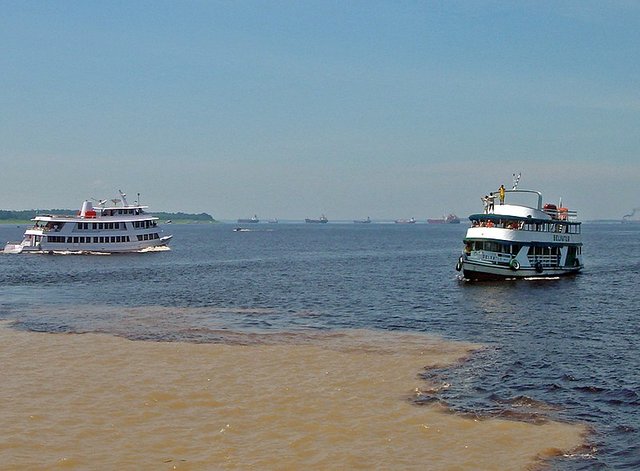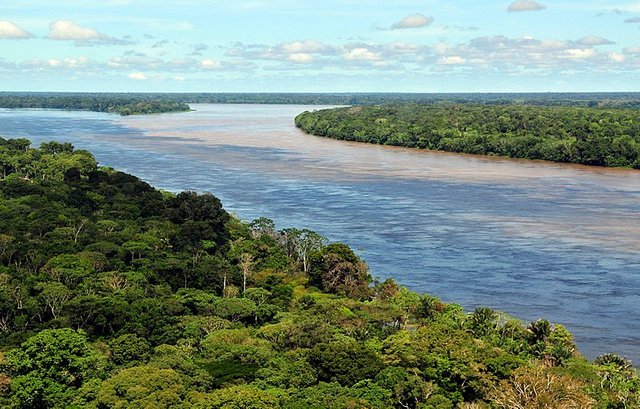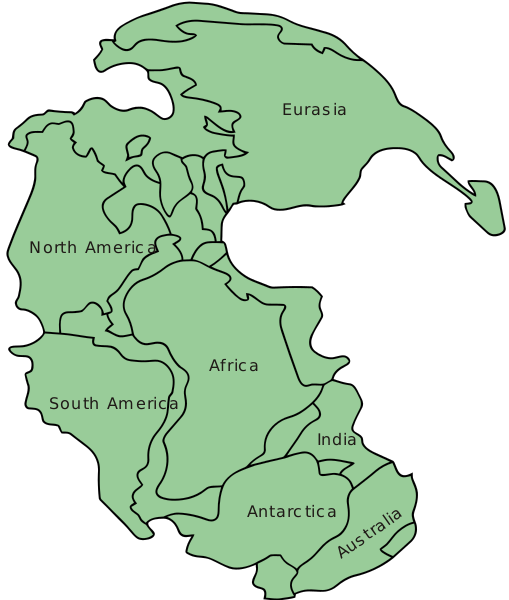The Mightiest River in All of History: Geology of the Amazon River Basin
The Amazon river isn't just the biggest river on the Earth- it's the biggest river known throughout the entire geological history of the Earth. It's astonishingly colossal. The mouth of the Amazon is over 100 miles across. The Amazon is second in length only to the Nile, only by a small amount, and even that's in dispute. The Amazon Rainforest represents half of the world's rainforest, even in its much diminished size. It's mindbogglingly huge.

The Amazon river near Iquitos, Peru. Despite its huge size in the photo, this is fairly far upstream. [Image source]
On the list of the 10 greatest rivers by discharge, the Amazon is number 1. #2, the Congo, has around 20% of the Amazon's total discharge. Two other rivers on the list- the Rio Negro and the Madiera- are also on the list, at #7 and #5, respectively. Number 4 on the list is the Orinoco, in the watershed just north of the Amazon.
There's never been a comparable river in the history of the planet, so far as we know. There's likely seldom been a forest comparable to the Amazon Rainforest, either. So where did it come from?
Geological History
During the Cretaceous, before Africa and South America split apart, the Amazon actually flowed westwards into the Pacific. When the continents split apart, a raised highland known as the Purus Arch formed on the east coast of South America. A small river (the eastern proto-Amazon) flowed eastwards into the sea, but the vast majority of the water in South America flowed westwards into the Pacific as the Western proto-Amazon. Around 15 million years ago, however, the Nazca Plate's subduction underneath the South American Plate gave rise to the Andes Mountains. The river's exit to the Pacific Ocean was cut off, and a huge inland sea known as the Pebas Basin began to form.
When the Andes closed off the Western proto-Amazon's connection to the Pacific, a great number of species were trapped in the Pebas Basin. To this day a great number of the inhabitants of the Amazon River are more closely related to Pacific than Atlantic species. Most of the 20 species of stingray in the Amazon are descended from Pacific rays, not Atlantic ones.
The Pebas Basin was still filled from the east (and nearly every other direction), but now drained into the Gulf of Mexico to the North. As the subduction zone made the Andes continue to rise and new mountain ranges to form, the Pebas Basin found itself being cut off from the Gulf of Mexico. The water began searching for another route, and finally began moving eastward. As it began spreading and looking for an exit, it began to transform from a salty inland sea to a colossal freshwater marsh- the largest we know of in geological history.
Finally, the Pebas Basin waters broke through the Purus Arch into the eastern proto-Amazon. It was a cataclysmic event, utterly disrupting the ecosystems that were there at the time as the eastern proto-Amazon was enlarged into something many times its former size. The enormous wetlands remained in the former Pebas Basin for quite some time.
The wetlands finally began to drain during the Pliocene. Around 5 million years ago during the beginning of the Ice Age, sea levels began to drop rapidly. As they did so, the wetlands began to drain, eventually forming the basin and forest we know today. The current channel of the Amazon alongside the Brazilian city of Manaus formed around 2500-5000 years ago as the river changed course.
The Hamza River
There's an enormous river in the Amazon River Basin that wasn't discovered until 2011. The Hamza River carries around 3% of the flow that the Amazon does, which is still an enormous river. The reason it took so long to be found? It's 4,000 meters (13,000 feet) underground. It's actually an aquifer filled by the Amazon, and follows the same general path.
In size, the Hamza actually dwarfs the Amazon. The Amazon is 1-100 km (.62-62 miles) in width. The Hamza ranges from 200-400 km. (120-250 miles). The flow rate in the Hamza is much, much slower, however. While the Amazon flows at 5 m/s (16 ft/s), the Hamza only flows at 1 millimeter per second. This incredibly slow rate of water flow has to do with the properties of aquifers. Aquifers aren't actually caves filled with water. Instead, they're just porous areas of rock that have had water fill the pores. Even in the more common type of aquifer that doesn't flow like a river water still moves about through these pores.
While other underground rivers do exist, they generally form in karst (limestone dominated) regions. These rivers actually often do resemble actual rivers flowing through caverns. I'll go more into underground rivers in another post, though.
Current State of the Basin
A river basin has to be maintained to continue flowing. Rainfall rates have to be kept up- and this is where the Amazon gets even more interesting. The might Andes Mountains do not cause a normal rain shadow effect bordering the Amazon- the leeward side of the Andes get far more rain than the seaward side, unlike the majority of mountain ranges. This results in an exceptionally dry coast, with most of the rain being dumped onto the side of the Andes draining into the Amazon River Basin. The specific reasons are fairly complicated, and have to do with the trade winds and the mighty Humboldt current.

The Andes Mountains. The large mountain in the foreground is Aconcagua, the largest mountain in the Andes and the largest mountain outside Asia. [Image source]
A huge portion of the Amazon's flow actually comes from rain within the basin itself, which has an interesting cause- the forest. The trees in the Amazon rain forest release immense amounts of water vapor into the air via transpiration. During the wet season, the cold fronts moving in result in this water vapor precipitating back out as huge rainfalls. In regions where the forest has been destroyed for cattle grazing, rainfall rates have dropped precipitously. The forest creates much of the rain that keeps it alive.
Due to the largely poor soil of the rainforest, many of the nutrients the Amazon depends on actually come from the Sahara desert, carried there by westward blowing winds during the Amazon wet season.
River Types
There are actually three types of tributary rivers to be found in the Amazon River Basin.
- Black Water rivers (Agua Negra): Blackwater rivers are almost black from the leached tannins from decaying leaves, but also have incredible water clarity- as much as 30 feet. They carry very few sediments, and as such very little in the way of nutrients for plants, resulting in even poorer soil than usual in the Amazon. Some native languages refer to these rivers as "rivers of hunger".
- White Water rivers (Agua Blanca): Sediment rich, brown colored rivers. Tend to contain an incredibly rich bio-load of species. These rivers generally run from the Andes, carrying the sediments eroded away from them.
- Clear Water rivers (Agua Clara): Clearwater rivers have clear, fairly pure water. Largely found in the highlands.

The confluence of the Rio Negro, the greatest of the blackwater rivers, with the Amazon, a whitewater river. [Image source]
Soil Types
In soils formed above the Pebas geological unit (formed out of the remains of the inland sea/giant swamp), more nutrients tend to be available. (Though most of the soil is still pretty poor.)
- Terra Firme: A nutrient poor soil found in the uplands of the forest away from the river. Does not flood during the rainy season. Makes up most of the soil of the Amazon.
- Terra Preta: Black Earth.” An exceptionally fertile man-made soil. It was made by adding bone, manure, and charcoal to the soil. The last is what gives the soil its color. Terra preta can last and remain fertile for millennia.
- Varzea: Low lying land around the river. Experiences seasonal flooding that can stretch miles away from the river. Exceptionally fertile (for the Amazon) when not flooded.
There are also other types of soil over the nutrient-poor Nauta formation, formed in a high energy mountain environment that was swiftly stripped of its nutrients. In fact, the Pebas formation soils are 15 times more fertile. The rainforest there tends to have shorter, thinner trees with much larger and well developed root systems, as well as areas with few trees and immense ground dwelling bromeliads.
The Future of the Basin
The mighty Orinoco river, the 4th largest river on the planet, appears to be undergoing river piracy by the Amazon. River piracy occurs when a stream or river is diverted from its own channel into the channel of another. There's a river, the Casiquiare Canal, that runs from the Orinoco into the Amazon. It's only draining a little bit right now, but on the scale of the rivers we're talking about even a little bit has resulted in the Casiquiare being a truly impressive and powerful river in its own right. The combination of the two rivers would on its own result in a truly astonishing behemoth of a river.
Unfortunately, deforestation poses immense potential damages to the system. The rainforest is as much responsible for maintaining the river and basin as they are for maintaining the forest. Without the rainforest, the region will begin to dry up- that is, dry up even more. Climate change has provoked a number of severe droughts recently- the drought in 2005 was the worst one in the basin in a century, followed by another in 2006, followed by one in 2010 that was comparable or possibly worse than the one in 2005. The forest might be able to survive on its own, but not in combination with the massive deforestation going on. Catastrophic collapse is a real possibility. We face a future where a landscape unlike anything else in the history of the Earth simply vanishes.

The Amazon River near Manaus. [Image source]
**********************************************
Bibliography:
https://en.wikipedia.org/wiki/Hamza_River
https://en.wikipedia.org/wiki/Amazon_rainforest
https://en.wikipedia.org/wiki/Amazon_basin
https://en.wikipedia.org/wiki/Amazon_River
https://en.wikipedia.org/wiki/Stream_capture
https://en.wikipedia.org/wiki/Casiquiare_canal
https://blogazonia.wordpress.com/2015/01/19/on-the-geology-of-the-amazon-river/
https://www.livescience.com/4253-amazon-river-flowed-ancient-times.html
https://news.mongabay.com/2012/01/geology-has-split-the-amazon-into-two-distinct-forests/
A Land of Ghosts, by David G. Campbell


Did not realize that when the Andes Mountains were created, the Amazon River's exit route was 'cut off' ♦♦ Very fascinating
And I liked your opening line ..where u said the Amazon River is colossal . Hadn't heard that word (colossal ) used very often here.
As to the stingray, well I took a class in Marine Biology -- so it was rather interesting to me when u explained
I hope the landscape doesn't disappear ♥ Those South americans need to get their act together & protect it (at least I hope they will)
Thank u for your thoughtful post ♦♦ It had good information
MERRY XMAS
I'm glad you liked it!
We do bear a responsibility to the Amazon as well- many lf the economic pressures droving deforestation are caused by America and other nations.
Nice post! I actually grew up near Manaus, a bit downriver from the confluence of the Rio Negro and the Solimões, so it's nice to see pictures again. The geological history is fascinating -- I never knew the whole continent used to drain to the west, but I suppose it makes sense. :)
I love geological history, and the Amazon has an especially interesting one.
Do you have any recommendations for places to visit in the Amazon? It's on my bucket list.
It's been a while since I've been back to Brazil, so things have probably changed a lot … But I think you might enjoy a trip up the Rio Negro from Manaus to see the Anavilhanas archipelago. It's super pretty, and there are some gorgeous white sand beaches up that way. You might have a look at the Ariau Towers in Manacapuru -- I've never been to the hotel itself, and it's kind of a touristy place, but Manacapuru is a nice city, or at least it used to be. :) And of course you'd have to go out and see the Encontro das Aguas (confluence).
North of Manaus, Presidente Figueiredo has some cool waterfalls. And if you feel like paddling a canoe through some tropical floodplains during high water, go downriver a bit from Manaus, toward the Lago do Puraquequara near where I grew up. That whole area is rich in history, both geologically and archaeologically.
Awesome, that all sounds amazing! Thank you so much!
Gave you an upvote as I felt your comment 'very good'.
Wish that I could go & view the waterfalls; #Nature is so great. I've seen a lot of Falls in my time (Yellowstone, Yosemite, Maui ).
FELIZ NAVIDAD !
Why thank you very much @janashby -- Feliz Navidad, Feliz Natal, Merry Christmas, and also Happy Holidays, too :)
Great information, I have always been intrigue by the amazon river especially the wildlife there. There's so much undiscovered species , who knows if we really start looking we may find some living fossils.
That'd be pretty cool!
What synchronicity! Great work! You must visit the Amazon. You deserve it! I am travelling, but when I return I post more pictures of the Amazon and Manaus and the meeting of the waters.
Awesome, can't wait to see them!
Great post I have seen the Nile in various locations including a couple of places that claim to be the source, but I have never made it to see the Amazon
I haven't seen either, so you've got one up on me!
I see
I have been lucky to have travelled a bit
Nice research. You really improved my knowledge about the Amazon river.
Glad to hear it!
wow the Amazon! One of the greatest river in the world!
It's an amazing river alright!
@originalworks
The @OriginalWorks bot has determined this post by @mountainwashere to be original material and upvoted it!
To call @OriginalWorks, simply reply to any post with @originalworks or !originalworks in your message!
Your Post Has Been Featured on @Resteemable!
Feature any Steemit post using resteemit.com!
How It Works:
1. Take Any Steemit URL
2. Erase
https://3. Type
reGet Featured Instantly – Featured Posts are voted every 2.4hrs
Join the Curation Team Here
@catfacts